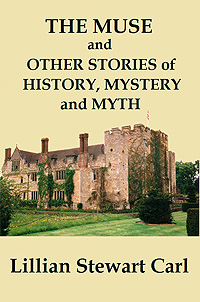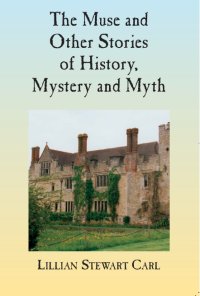

The Muse and Other Stories of History, Mystery, and Myth
August 2007
Delphi Books
ISBN-10: 0976518554
ISBN-13: 978-0976518556
The Muse is also available in multiple electronic versions.
Find the Book |Reviews | Excerpt |
In The Muse and Other Stories of History, Mystery, and Myth, Lillian Stewart Carl sweeps you through a magical mystery tour of history.
Thirteen stories take you from the British Colonies in America and India to medieval England and revolutionary Scotland. Vividly realized worlds include Shakespeare's timeless Illyria and the very real twenty-first century.
People on-screen and -off include Thomas Becket and Thomas Jefferson, Charles Dickens and Bonnie Prince Charlie, Queen Elizabeth I at her height, and Ann Boleyn, her mother, at her depth. Carl's salves and soldiers, sorcerers and sinners--and even a striped cat or two--are often sleuths and always good company.
Humankind's great passions--greed, love and hate, the rights of man (and woman)--provide motives for murder and more. And lives are touched by fantasy, because along that shore between the present and the past, nothing is certain.
The
Muse and Other Stories includes twelve stories especially commissioned for theme
anthologies (three of which were reprinted in "Best Of" anthologies) and a story
from a magazine, plus new Author's Comments and an essay on writing short
historical mystery.
A Stake of Holly
A Mimicry of Mockingbirds
Cold as Fire
A Rose with All Its Thorns
A Dish of Poison
The Diamonds of Golkonda
The Eye of the Beholder
Way Down in Egypt’s Land
Over the Sea from Skye
The Rag and Bone Man
Sardines for Tea
The Necromancer’s Apprentice
The Muse
Reviews
"The Muse and Other Stories of History, Mystery and Myth allows the author
to explore a range of historical periods, and literary classics. Carl has
intriguing plots in which she challenges the reader to look at culture with a
different eye. Lillian Stewart Carl invites the interested reader into a
collection of stories filled with the magic of the past."
-- Lesa Holstine,
Lesa's Book Critique
"Top-notch entries include...Lillian Stewart Carl's 'Way
Down in Egypt's Land,' a marvelous tale about 19th-century slavery..."
-- Publisher's Weekly
"Inspired contributions include...Lillian Stewart
Carl's 'The Necromancer's Apprentice,' which presents an interesting solution to
the actual mystery surrounding the death of Amy Robsart, wife of Elizabeth I's
favorite lord, balancing wizardry with astute deductions about the political
motives of those who stood to benefit."
-- Publishers Weekly
Excerpt
Writing historical mystery short stories: How to keep the characters under control.
One of the basic skills of short-story writing is focusing tightly on one situation, one setting, and one group of characters, keeping the story immediate rather than sounding like the synopsis of a novel. It goes without saying that a mystery short story, historical or otherwise, will not have nearly as many red herrings or as intricate an investigative process as a mystery novel will have.
I use one strong point of view to tell the story, and through this person’s thoughts and observations drop in just enough description to set the scene. The problem with historical short stories is that setting the scene is a bit trickier. I have to clue the reader in to the time and the place very quickly with, say, “The Luftwaffe was hammering the dockyards at Bristol again.” I can’t tell the entire history of the period in a short story.
I introduce secondary characters with just one quick identifier, not a full backstory. I try to limit the number of characters to those needed for the plot, ignoring all the others who would have been there at the time. Because my stories tend to be longer ones, between 6000-8000 words, I do have some leeway.
In “The Necromancer’s Apprentice,” I focused on historical characters Robert Dudley and Queen Elizabeth I, and on Erasmus Pilbeam, my imaginary magician and sleuth, and his assistant. I did not introduce the plethora of courtiers, diplomats, and other figures who would have attended the queen at court. Since Pilbeam’s investigations are secret, keeping him away from the court wasn’t difficult.
In “A Mimicry of Mockingbirds” the protagonist is Thomas Jefferson as a young man living in Williamsburg, Virginia. Again, I’m dealing with several historical characters as well as my imaginary ones, but by having Jefferson interact with only one person at a time—until the “who done it” revelation, at least—I was able to keep the story in focus.
Two of my stories ended up with a mob of characters: “The Rag and Bone Man” and “The Eye of the Beholder.”
In the former, a pilgrim is murdered during a visit to the shrine at medieval Walsingham Priory. Here I had to not only set up the members of the pilgrim group, but also the prior and his staff. One pilgrim is identified as Isabella, “the king’s mother”. Tempting as it was to give her entire back story—and quite a story it is, if badly mangled in the film Braveheart—what was important to the story was that she was still wealthy and influential in retirement, and that she was a member of the French royal family.
In the latter story, I have a group of recovering WWII airmen at a stately home turned hospital near Glastonbury. My protagonist is an American, enough of a fish out of water that he can notice and comment on the things the reader needs to know. I chose one or two other people out of the wounded airmen and hospital staff to play major roles and kept everyone else in the background.
In any short story I imagine myself as a movie cameraman, focusing on a character or a clue and letting everything else fuzz out behind the main actors. Even if those blurry shapes are intriguing historical details or characters, if they’re outside the scope of the story, then they’re out!
Reprinted with permission from HOW TO WRITE KILLER HISTORICAL MYSTERIES: THE ART AND ADVENTURE OF SLEUTHING THROUGH THE PAST, edited by Kathy Lynn Emerson, Perseverance Press, 2008. Winner of an Agatha Award!





